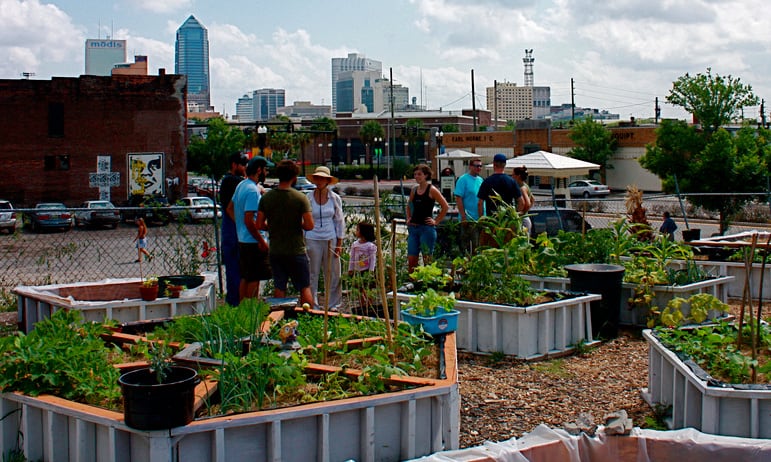The Only Guide for City Blooming
The Only Guide for City Blooming
Blog Article
A Biased View of City Blooming
Table of ContentsCity Blooming - TruthsSome Known Questions About City Blooming.The 25-Second Trick For City BloomingCity Blooming Things To Know Before You Get ThisThe Buzz on City Blooming
Intrigued in expanding food for sale in the City of Chicago? Considering starting a neighborhood yard? Modifications to the Chicago Zoning Regulation enable agricultural usages like neighborhood yards and urban ranches in many parts of the city. Below is a list of often asked concerns concerning the regulations and guidelines that growers should consider when intending a metropolitan agriculture project.
The zoning change does not change any various other codes dealing with composting, building authorizations, buying or leasing City had residential or commercial property, service licenses or environmental contamination. There are existing codes that control these concerns and they remain in complete effect and might apply to your task. Community gardens are commonly had or handled by public entities, public companies or community-based organizations and preserved by volunteers.
Urban ranches grow food that is intended to be sold, either on a nonprofit or for-profit basis. Due to their commercial purpose, city ranches call for a company permit. Yes. A community garden is enabled to market excess produce that was grown on website if the sales are accessory or secondary to the yard's key purpose described above.
City Blooming - The Facts
Composting is enabled however only for plant product that is created and utilized on site. The quantity of compost product can not surpass 25 cubic backyards at any offered time according to the criteria in 7-28-715 of the City's Municipal Code. Yes. Because the dirt at many new garden sites requires modifying, garden compost, dirt, timber chips, or other materials can be gotten to build or boost the growing area - eco-friendly practices.

If a building license is needed then the hoophouse will certainly be taken into consideration an accessory building. You can learn more concerning the building permit requirements by getting in touch with the Division of Buildings. The 25,000-square-foot dimension limitation is intended to prevent a solitary neighborhood garden from controling a provided block or taking away from the block's existing residential or commercial personality.
The limitation does not use to yards found in Public Open Space (POS) districts. Can there be even more than one area garden that is 25,000 square feet on a solitary block? Fencing is not required, however, yards that have big car park locations might be called for to install fence or other landscape design functions.
The Definitive Guide for City Blooming
B1 & B2 districts require that all industrial use activities be performed inside your home. Is secure fencing needed for urban farms? Fences might be called for, along with landscape design and testing, for specific car parking locations and outdoor job or storage space areas depending on area and the certain activity taking area.
Yes. Urban ranches need structure authorizations and zoning approvals prior to construction. Various other kinds of city testimonial may be needed relying on certain structures, activities, dimension, landscape design, licensing, public health and stormwater monitoring problems. A lot of these needs are determined in the job style or permitting procedure, however, the applicant may be liable to individually determine particular licenses or permits that might be called for.
Yes. The kind of license is determined by what is occurring at the site. The Department of Business Matters and Consumer Security can assist establish the details kind of business permit that's required. Yes. Off road car park is needed for most business projects in Chicago. The called for variety of garage is based on the number of staff members servicing website and not the square footage of the expanding room.
The Buzz on City Blooming

Yes. A city farm can offer garden compost material produced on website, nonetheless, the operation needs to abide with the policies in 7-28-715 of the visit homepage Chicago Municipal Code. Yes. Aquaponic systems are enabled inside on metropolitan ranches in several zoning districts. Nevertheless, a zoning testimonial and building permit is needed in order to set up frameworks or systems and a service certificate is called for as defined over.
As much as 5 hives or swarms of honey might be maintained as an accessory usage. Nonetheless, beekeepers need to sign up with the Illinois Division of Agriculture. For additional information about the proposed zoning amendment you may contact the Department of Housing and Economic Development, Bureau of Preparation and Zoning at 312.744.8563.
, which takes area in country areas at the edge of suburban areas.
The Main Principles Of City Blooming
It can include a motion of organic farmers, "foodies" and "locavores", that seek to form socials media founded on a common values of nature and community holism. These networks can establish using formal institutional support, becoming incorporated right into regional town as a "change community" motion for lasting metropolitan advancement.
In either situation, the extra straight accessibility to fresh vegetable, fruit, and meat items that might be know with urban agriculture can enhance food safety and security and food safety and security while reducing food miles, causing reduced greenhouse gas discharges, consequently adding to climate modification reduction. A few of the initial proof of city agriculture originates from Mesopotamia.
Report this page